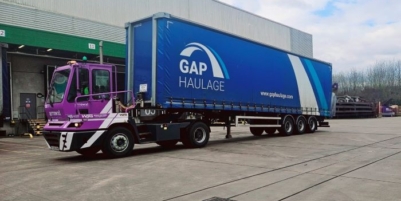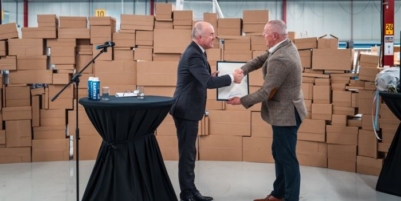-
Nutrivend selects Forterro’s Orderwise to support online expansion and streamline operations - April 11, 2025
-
ARROWXL LAUNCHES AMBITIOUS ZERO WASTE ROADMAP - April 8, 2025
-
THE BCMPA’S NEW CAMPAIGN DRIVES OUTSOURCING SUCCESS IN Q1 - April 7, 2025
-
BLACKOUT TECHNOLOGIES TARGETS TELEMATICS-INTEGRATED MOBILE DEVICE BLOCKING TO COMBAT SMARTPHONE DISTRACTION - April 1, 2025
-
Sparck Technologies awarded Royal designation - March 27, 2025
-
OpenADR Alliance announces first OpenADR 3.0 certified products with EVoke Systems, E.ON Energy and Universal Devices - March 25, 2025
-
Growing fulfilment and contract packer appoints new Managing Director - March 25, 2025
-
When is it time to invest in a WMS? Understanding the key trigger points - March 25, 2025
-
eCapital helps Vantage Recruitment on its journey to financial success - March 24, 2025
-
Hugo Beck Celebrates 70 Years of Packaging Innovation with Open House Events - March 20, 2025
Alphabet (GB) has released its Fleet Report 2022, unpacking trends from over the last 12 months and looking at how they are likely to shape 2023 and beyond.
From increased costs and supply chain delays to upcoming net zero deadlines and regulatory changes, 2022 has presented businesses with another year of turbulence and complexity. Fleet decision-makers have been faced with the difficult task of navigating the magnitude of these hurdles with very little certainty, making planning for and anticipating future mobility needs extremely challenging.
The past year has demonstrated the importance of embracing operational flexibility, as well as highlighting the value expert partners can offer to help businesses respond with resilience and agility. Alphabet’s Fleet Report 2022 reviews some of the events from the last 12 months and discusses what fleet managers might expect to see on the road ahead.
Supply chain impact
The backlog created by ongoing supply and manufacturing challenges is expected to continue into the second part of 2023. Long lead times and lack of vehicle availability have stunted the potential growth of fleets in the UK, with the British Vehicle Rental and Leasing Association (BVRLA) reporting a decrease in fleet size of almost 9,000 units in Q2 this year compared to Q1.
Positively, demand for company cars remains high, and fleet and business new car registrations experienced a 57% year-on-year uplift in November according to data from The Society of Motor Manufacturers and Traders (SMMT). Leasing companies have been working closely with customers, manufacturers, and retailers to help manage the impact of supply shortages by expanding vehicle choice lists to include more readily available options, leveraging relationships to access to pockets of stock, and crucially, anticipating disruption. This has meant planning ahead to get orders in as early as possible – factoring in longer lead times and the need for rental vehicles to help plug any gaps.
Although a return to ‘normal’ is not on the horizon just yet, it is essential that fleet managers understand the impact of these market forces, and what can be done to help guide their business and drivers through it in the best way possible.
The Great British Electrification
With net zero deadlines on the horizon, low and zero-carbon approaches remain a priority for businesses and huge strides have been made toward fleet electrification as a result. Alphabet’s new vehicle order figures show that year-to-date PHEV orders are almost level with petrol vehicles at 31% and 33% respectively, while BEV orders have increased by 19% this year, totalling 27% of all new orders.
We’ve seen salary sacrifice car schemes surge in popularity this year, being welcomed by both businesses and employees as an appealing, cost-efficient way for drivers to access EVs, particularly as the economic circumstances have placed budgets under more pressure. However, The Chancellor’s Autumn statement could slightly impact EV uptake as 2025 draws nearer, with businesses needing to accommodate upward changes to BIK and VED rates. Whilst seemingly counterintuitive to further incentivising the switch to EVs, the positive take from the announcement is the much-needed certainty fleets now have on ongoing VED and BIK rates from 2025, meaning businesses can properly plan their future fleet strategies. As such we expect to see continued momentum towards electrified fleets as everyone works to meet both the 2030 deadline and wider business sustainability targets.
Charging forwards with infrastructure
The successful implementation of accessible charging infrastructure across the UK is essential in the transition to EVs, ensuring drivers are able to charge vehicles with convenience and ease wherever they are. Development of further workplace charging has been encouraged by the extension of the current 100% first-year allowance for expenditure incurred on electric charge-point equipment until 2025, due to be legislated in the 2023 Spring Finance Bill. This two-year extension means businesses can continue to receive incentives for investing in rolling out their own charging infrastructure, increasing charging options for employees and helping to make the switch to EVs an easier decision for drivers and fleet managers alike.
And for those businesses that get ahead with the set-up of their charging infrastructure, there’s the opportunity to be at the front of the queue when it comes to embracing innovation and finding new ways of bringing in additional revenue. This could include introducing technology that enables charging facilities to be extended for public and wider community use, with reduced rates for public charging outside of business hours, for example.
We’ve also seen a 33% increase in public EV charge points since November 2021, providing more options for EV drivers, and adding to the four-fold increase of public charge points in the past few years. This is a critical piece of the puzzle if the UK is to meet the upcoming 2030 deadline. However, driver concerns over broken or busy public charge points remain challenges to overcome with extra consideration and planning required for those who are unable to charge at home or at work. There is also still much work to be done to make public charge points more suitable for commercial vehicles, as well as reducing geographical and cost disparity to help make EV charging more accessible for all.
Focus on small and medium fleets
This year unprecedented uncertainty has placed fleet managers under increased pressure, but this is particularly the case for those in charge of small and medium fleets. Businesses with smaller fleets rarely have the benefit of a full-time fleet manager and instead, fleet management is typically part of a much bigger HR, finance or general management role. As a result, the time available to dedicate to reviewing and addressing evolving external factors and fleet requirements is often limited and can be a stretch on existing roles within the business.
Next year, with ongoing EV developments and changes to legislation, we expect to see more full-service offerings from leasing providers being made available to managers of small and medium fleets to support them with navigating the changing fleet landscape and their transition to electric. For those providers, this will most likely mean a diversified strategy that focuses on the requirements of both SMEs and smaller fleets within larger companies to help businesses access the same expertise and breadth of services currently enjoyed by larger corporates.
Caroline Sandall-Mansergh, Consultancy and Channels Development Manager, Alphabet GB said: “2023 follows an action-packed year of advancements being made in terms of both EV adoption and technology and new products and services being introduced to better support drivers and fleet managers. Although global supply chain issues, fluctuating costs, and changes in taxation and legislation will continue to challenge and shape mobility, we’re focused on leveraging the opportunities for innovation and added value that this evolving landscape presents to our business and our customers. A desire to make mobility easy underpins everything we do and we will continue to bring this to life with expert support, end-to-end tailored solutions, and a partnership our customers can rely on, whatever lies ahead.”
































